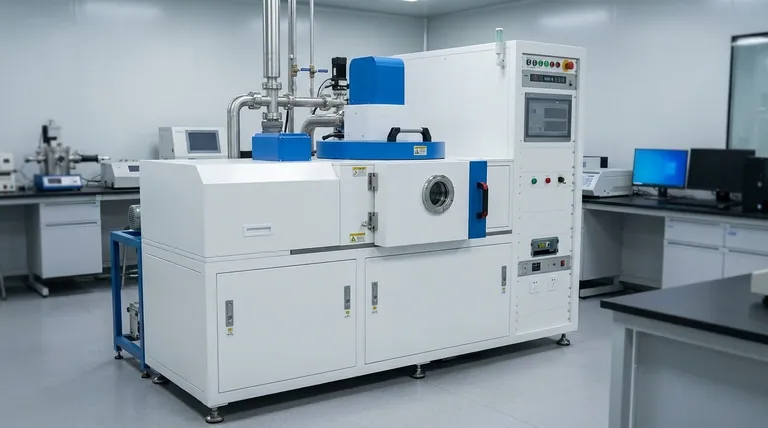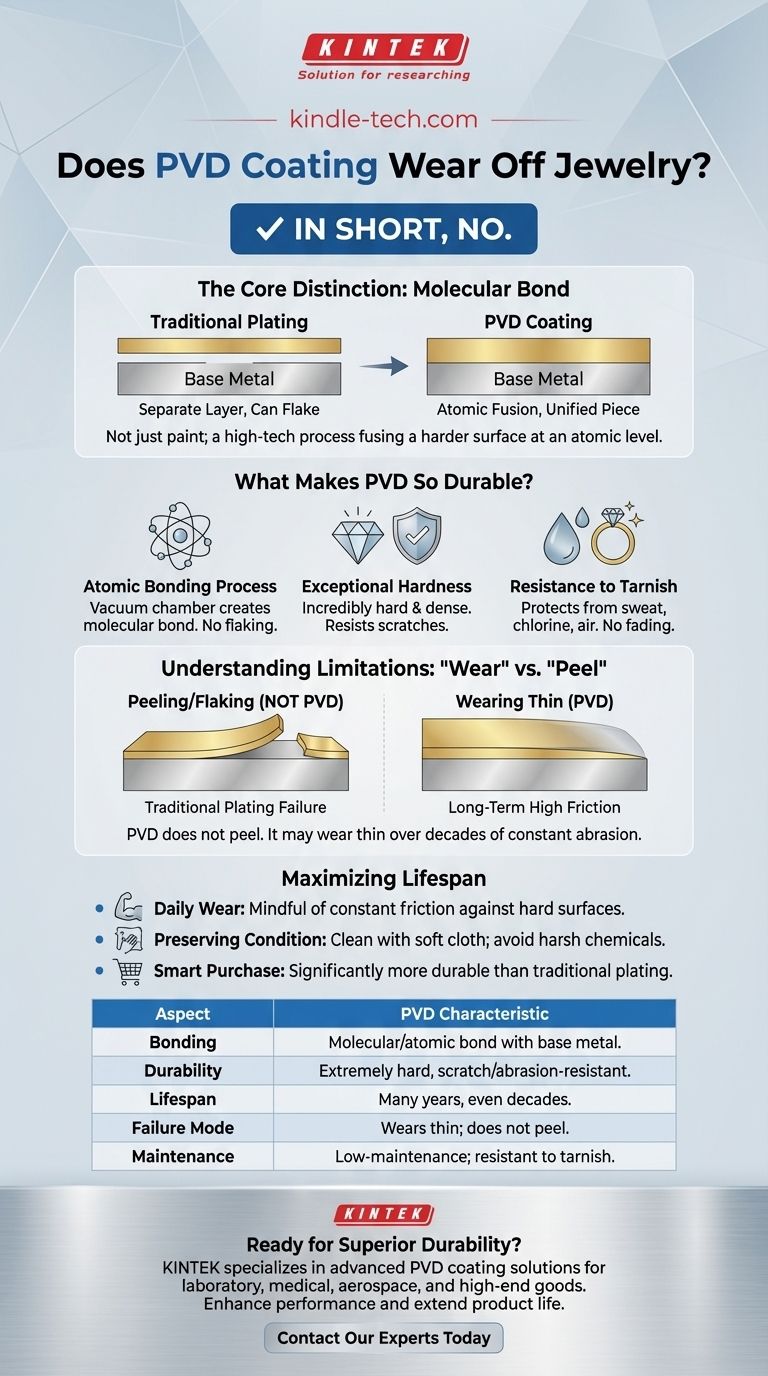In short, no. PVD coating does not simply flake or peel off on its own. It is an exceptionally durable coating that forms a molecular bond with the base metal, making it highly resistant to the kind of wear and tear that affects traditional plating. While not indestructible, a properly applied PVD coating can last for many years.
The core distinction to understand is that PVD coating is not just a layer of paint; it is a high-tech process that fuses a new, harder surface directly onto the jewelry at an atomic level. This makes it a superior choice for durability and longevity compared to conventional plating methods.

What Makes PVD So Durable?
The exceptional resilience of Physical Vapor Deposition (PVD) coating comes from the specific way it is applied, which fundamentally changes the surface of the jewelry.
The Atomic Bonding Process
Unlike traditional electroplating that simply lays a thin layer of metal on top of another, PVD uses a vacuum chamber to molecularly bond the coating material to the base metal. This creates a single, unified piece rather than a separate layer that can chip or flake away.
Exceptional Hardness
The resulting P-VD coated surface is incredibly hard and dense. This inherent hardness makes it extremely difficult to scratch or abrade, protecting the jewelry from the minor impacts and friction of daily life.
Resistance to Tarnish and Fading
The bonded layer acts as a protective shield for the base metal underneath. It is highly resistant to the effects of sweat, chlorine, and air, which prevents the tarnishing and color fading that plagues many other types of jewelry.
Understanding the Limitations
While PVD is a superior technology, no coating is permanent. Understanding its limits is key to managing expectations for longevity.
"Wear" vs. "Peel"
It's critical to distinguish between wearing down and peeling off. A PVD coating will not peel or flake. However, over a very long period of constant, high-friction abrasion, the coating can eventually wear thin in specific spots, such as the edge of a ring that constantly rubs against hard surfaces.
The Role of Coating Thickness
The lifespan of a PVD coating is directly related to its thickness. A thicker, well-applied coating can last for a decade or more with proper care, while a very thin coating will naturally have a shorter lifespan under heavy use.
Proper Care is Still a Factor
Although PVD jewelry is low-maintenance, it is not invincible. Regularly exposing it to harsh chemicals or abrasive materials will accelerate wear. The durability of PVD assumes reasonable care and maintenance.
How to Maximize the Lifespan of Your Jewelry
Your goal determines how you should select and care for your PVD-coated pieces.
- If your primary focus is daily, long-term wear: Choose high-quality pieces and be mindful of constant friction against hard surfaces, like desks or weights at the gym.
- If your primary focus is preserving pristine condition: Clean your jewelry with a soft, dry cloth and avoid direct contact with perfumes, lotions, and harsh cleaning agents.
- If your primary focus is making a smart purchase: Recognize that PVD offers significantly more durability and value than traditional gold plating, ensuring your jewelry retains its brilliance for much longer.
Ultimately, PVD coating offers one of the most durable and resilient finishes available in the jewelry industry today.
Summary Table:
| Aspect | PVD Coating Characteristic |
|---|---|
| Bonding | Molecular/atomic bond with base metal |
| Durability | Extremely hard, scratch and abrasion-resistant |
| Lifespan | Can last for many years, even decades |
| Failure Mode | Wears thin over time; does not peel or flake |
| Maintenance | Low-maintenance; resistant to tarnish and chemicals |
Ready to achieve superior durability and longevity for your products?
At KINTEK, we specialize in advanced PVD coating solutions for laboratory equipment and precision components. Our coatings provide exceptional hardness, corrosion resistance, and a flawless finish that stands up to demanding environments.
Whether you're developing medical instruments, aerospace components, or high-end consumer goods, our expertise ensures a coating that enhances performance and extends product life.
Contact our experts today to discuss how KINTEK's PVD coatings can add value and durability to your next project.
Visual Guide

Related Products
- RF PECVD System Radio Frequency Plasma-Enhanced Chemical Vapor Deposition RF PECVD
- Vacuum Hot Press Furnace Machine for Lamination and Heating
- Chemical Vapor Deposition CVD Equipment System Chamber Slide PECVD Tube Furnace with Liquid Gasifier PECVD Machine
- VHP Sterilization Equipment Hydrogen Peroxide H2O2 Space Sterilizer
- Split Chamber CVD Tube Furnace with Vacuum Station Chemical Vapor Deposition System Equipment Machine
People Also Ask
- How does RF power create plasma? Achieve Stable, High-Density Plasma for Your Applications
- What is the principle of plasma enhanced chemical vapor deposition? Achieve Low-Temperature Thin Film Deposition
- What is an example of PECVD? RF-PECVD for High-Quality Thin Film Deposition
- How are PECVD and CVD different? A Guide to Choosing the Right Thin-Film Deposition Process
- What are the applications of PECVD? Essential for Semiconductors, MEMS, and Solar Cells



















